#waitforwhite
Photo
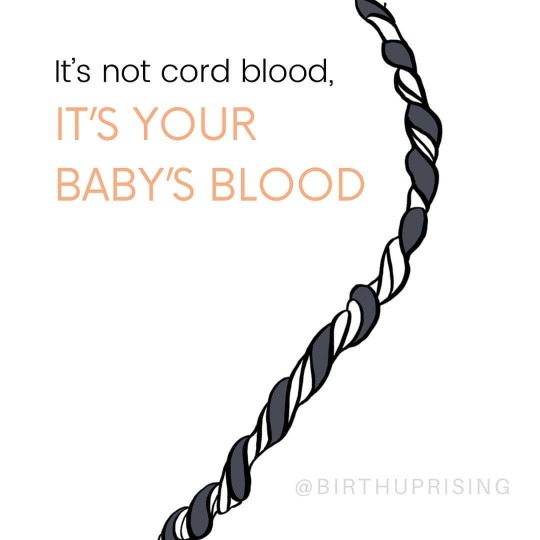
Reposted from @birthuprising At birth, ⅓ (or more) of your baby’s blood is still in the placenta. That means if you immediately cut the cord, your baby is missing A LOT of blood. If you were missing ⅓ (33%) of your blood, your heart and respiratory rates would increase, your blood pressure would drop, and you would become anxious and confused. If you lost 40% of your blood, all those symptoms would be worse and you would become lethargic. If you lost more than 40% you would die. So how long should you wait after birth to clamp the cord? Ideally you would “wait for white”. This means the cord isn’t clamped until it has stopped pulsing and turned white because all of the blood is now inside the baby. This is usually over 5 minutes (I’ve waited until the birth of the placenta with my two homebirths [about an hour]). But delaying cord clamping for even 60 seconds has been shown to have benefits including: 🔆 Increased hemoglobin 🔆 Increased iron 🔆 Increased blood pressure (early clamping means BP can be too low) 🔆 Increased urinary output 🔆 Increased body temperature (early clamping babies are colder) If baby is having a slower transition to breathing outside the womb upon their birth, keeping them attached to the cord will also continue to provide them with oxygen until they begin breathing on their own. Did you delay cord clamping with your babies? . . . . . . . . . . . . . . #birthfacts #delayedcordclamping #dcc #waitforwhite #cordclamping #umbilicalcord #evidencebasedpractice #bornathome #newborn #nicu #nicubaby #nicumom #hospitalbirth #healthybaby #physiology #physiologicalbirth #postpartum #newbaby #newmom #birthplan #birthoptions #birthmatters #knowyouroptions https://www.instagram.com/p/CYic4d3LcOl/?utm_medium=tumblr
#birthfacts#delayedcordclamping#dcc#waitforwhite#cordclamping#umbilicalcord#evidencebasedpractice#bornathome#newborn#nicu#nicubaby#nicumom#hospitalbirth#healthybaby#physiology#physiologicalbirth#postpartum#newbaby#newmom#birthplan#birthoptions#birthmatters#knowyouroptions
0 notes
Text
The rights of the newborn, to it's own blood - Your baby needs it's blood and stem cell infusion, with all it's benefits, at the time of birth, as nature intended it.
We admire the local and global work that Ibu Robin Lim has been carrying out for decades for the rights of women and especially babies. Have you considered that it's a newborn's right to have it's own blood?
Midwife Lina Duncan states: “There is also work across the globe to ensure babies get their own blood. One of the ways we can help is by our language. It's not ‘cord blood.’ The blood belongs to the baby- it’s ‘baby’s blood.’“
Please read on and comment in response to Ibu Robin Lim's thoughtful and compassionate article.
[NOTE: Unfortunately she is unable to attend the conference to speak as we had all hoped. Regardless, we propose change to the practices across Asia to better serve our babies. May everyone be inspired through her research, writing and compassionate work.]

The Necessary Question of Infants’ Human Rights at Birth…Are there Vampires in the Birth Rooms?
Parents, grandparents, aunts, uncles, siblings, families, midwives, doulas, doctors, nurses, hospital administrators and legislators…we are BirthKeepers. It is our responsibility to ask the next question concerning human rights in childbirth. As BirthKeepers, it is we who are given the sacred responsibility to protect the mothers and our incoming humans, the newborns, at birth and as they grow, for they are the future EarthKeepers. My question now is: “Are we allowing our health providers to rob our babies of their full potential of health, intelligence, immunity and longevity, at birth?”
In Germany, children under the age of 18 are not eligible to donate blood. Blood donations are generally no more than 500 ml, which is 1/10th of the average adult blood volume. Blood donors must weigh at least 50 kg.
Yet, all over the world, in nearly every single medical institution where babies are born, newborns (usually weighing only between 2 and 5 kilograms (4.4 to 11 lbs.) are being denied up to 1/3 of their blood volume. This happens when the umbilical cord is immediately clamped and cut, by the doctor or midwife, just moments after the baby is born.
At the moment of birth, newborn infants have a blood volume of approximately 78 ml/kg, which means about 273 ml, at an average weight of 3.5 kg. This is what the newborn is left with when the umbilical cord is immediately clamped and cut.
Research has shown that when umbilical cord-clamping is delayed for 5 minutes, a newborn’s blood volume increases by 61% to 126 ml/kg, for an average total of 441 ml. This placental transfusion amounts to 168 ml for an average 3.5 kg (7.7 lb.) infant. One-quarter of this transfusion occurs in the first 15 seconds, and one-half within 60 seconds of birth.

Is taking 1/3 of a mammal’s blood supply harmful?
How then can it be legal for hospital protocols and practices to harm newborns, by robbing them at birth of so much of their blood? I have reviewed the extensive research and the evidence, and found absolutely NO benefits for newborn babies, when their umbilical cords are immediately clamped and cut at the time of birth. In fact, the studies prove this to be a harmful practice.
At the time of birth up to 1/3 of each baby’s blood supply is traveling from the placenta via the umbilical cord to the baby. Calling this blood “cord blood” is doublespeak, intentionally ambiguous language, meant to fool parents into misunderstanding. The fact is, the blood present in the umbilical cord at the time of birth is truly the BABY’S blood.
No parent would sign a waiver (often presented in fine print as part of a long informed consent, given to mother when she arrives at a hospital in labor) giving away 1/3 or any amount of the baby’s blood. Yet, thousands of times, every day and night, parents are deluded into giving away a significant part of their baby’s precious blood supply! The majority of parents in the world are not even asked if the baby’s umbilical cord may be immediately severed.
I am quite sure that if I were to remove 1/3 of even one adult patient’s blood, without his or her consent, it would be considered a crime. There would be media outcry against me, and I would be prosecuted. How then is it that people tolerate the same unfair treatment of human neonates?
A mountain of research shows that by simply delaying the clamping and cutting of babies’ umbilical cords, our newborn children suffer less trauma, fewer inner cranial hemorrhages, and have higher stores of iron at 4 months of age, and even up to 8 months after birth (1) (2) (3). The nutrients, oxygen and stem cells present in the blood transfused into babies by the placenta, when cord severance is delayed, ensures that the body’s tissues and organs are properly vitalized, supplied with energy, and nourished. This translates into improved health, heightened immunity, increased intelligence and potential longevity.
In addition, keeping the umbilical cord intact for some time at birth means that the baby must stay skin to skin with mother. This eliminates or greatly reduces the potential for birth trauma. Research has proven that babies born without trauma enjoy an intact capacity to love and trust. (Michel Odent OBGYN “The Scientification of Love, see entire book)
The simple, natural, common-sense practice of giving the placenta time to do its job, of delivering to the baby his or her full blood supply, has been criticized and NOT implemented by the very doctors and hospitals who have taken an oath, to “Never Do Harm.”

The origins of immediate premature cord cutting
The imposed medical habit of immediately clamping and cutting babies’ umbilical cords has not been with us so long (just over 200 years) and yet, in the minds of many healthcare providers it is erroneously considered “normal” and “necessary.” Clearly the research proves it is not necessary, nor is it evidenced based practice.
“Another thing very injurious to the child, is the tying and cutting of the navel string too soon; which should always be left till the child has not only repeatedly breathed but till all pulsation in the cord ceases. As otherwise the child is much weaker than it ought to be, a portion of the blood being left in the placenta, which ought to have been in the child.”
~Erasmus Darwin, Zoonomia, 1801
The habitual practice of immediate umbilical cord clamping and cutting began in the 1960s when an unproved hypothesis or theory arose among physicians thinking that immediate cord severance would prevent jaundice. If this is true, why do so many babies who have had their cords immediately clamped and cut need phototherapy for pathological jaundice? Research has proven that there is no greater risk of pathological jaundice for newborns whose cord clamping and cutting is delayed.
Another theory was that early cord clamping would prevent Polycythemia, or too much hemoglobin. Some research does show an increased concentration of hemoglobin in the delayed cord clamping group, but it has not harmed babies, nor is it a significant argument for immediate cord severance. (4)
When immediate umbilical cord clamping and cutting was introduced, it was never questioned. NO research was conducted to determine if it was a safe practice. It was just done for convenience. Doctors, nurses and midwives began to follow the trend, like sheep wearing blinders. Later, they justified it with myths about delayed cord severance causing jaundice. Few asked the questions I am asking today; “What about the Baby?” “What are the Babies’ human rights?” “Is the practice and protocol of immediate umbilical cord severance harming our children?” “Is it sabotaging breastfeeding and bonding?” “Is it impairing our children’s birthright to their full potential of health and intelligence?” At this junction of herstory and history, many BirthKeepers are asking these very questions. (5)
Research proves that immediate or early umbilical cord severance is detrimental to our newborn children, but no one seems alarmed. Are we hypnotized? Why are we trusting medical professionals, who profits from denying our offspring their very blood? Stealing blood is what vampires do!
Thinking, caring parents and grandparents have concluded that OBGYNs and midwives who insist on routine, immediate umbilical cord cutting are simply protecting their right to practice with impatience, and what they deem ‘efficiency,’ with no regard for the rights of the baby, who cannot protest.
Another issue is financial profit. Stem cells are valuable, blood is valuable, and hospitals sell babies’ blood for transfusions and for research. (6) Many parents are asked to donate their babies cord blood to science or to help others. Did you know umbilical cords are marketed for transplants? Placentas have also been sold to cosmetic companies to be used in beauty supplies, though this is now much less common.
In some countries (especially the US), fear of litigation has been used to justify early cord-cutting. In 1995 the American Academy of Obstetricians and Gynecologists (ACOG) released an Educational Bulletin (#216) recommending immediate cord clamping in order to obtain cord blood for blood gas studies in case of a future lawsuit. They did this because deviations in blood gas values at birth can reflect asphyxia, or lack of. Lack of asphyxia at birth is viewed as proof in a court of law that a baby was healthy at birth.
Following an unpublished letter sent to ACOG by Dr. Morley, ACOG withdrew this Educational Bulletin in the February 2002 issue of Obstetrics and Gynecology, the ACOG journal. (7) This action released them of liability resulting from their previous bulletin #216 of 1995. Parents and all BirthKeepers must ask; WHY, if ACOG has withdrawn its erroneous instruction to doctors, to immediately clamp and cut babies’ umbilical cords, is it still universally and dangerously practiced?
Midwives and doctors who propose the healthy process of placental transfusion at birth by delaying umbilical cord clamping and cutting are criticized and charged with the burden of proving that letting nature take her course is safe!
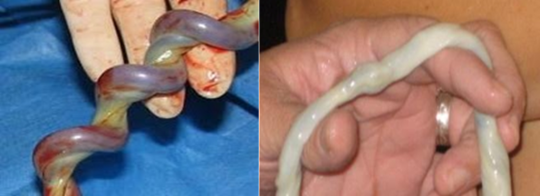
The difference between a cord at the time of birth versus at the time of the cessation of pulsation (Photo credit: Kate Emerson, www.cord-clamping.com)
Cord Baby blood banking
The question of cord blood banking arises. First of all, remember that it is actually baby blood, not cord blood. That said, there are two directions parents are encouraged to choose from: banking their baby’s stem-cell-rich blood for donation, presumably to help someone in the future, an altruistic idea; or, banking baby’s blood for future personal use, should the child develop a disease perhaps treatable by blood transfusion. The most touted of the presumably treatable diseases is leukemia. The probability that a person in the course of his or her life will ever need a stem cell transplant (whether from umbilical cord blood or bone marrow) has been estimated by the University Hospital in Heidelberg at 0.06% to 0.46%, depending on age. Correspondingly low, the probability that one's own cord blood would be used in a transplant is between 1: 1400 and 1: 200,000. (8) The technology to properly store this baby blood is still not adequate to insure that the blood will be useable in the future.
Parents are driven by fear and love for their baby to pay between 1,500 and 2,000 euros or more, for the initial “harvesting” of their baby’s blood at birth. Storage programs, for between ten and twenty-five years cost between 90 and 120 euro per year. Parents are asked to gamble that technology will advance enough to make their investment useful, should the worst case scenario for their child’s health arise.
But it must be said out loud and precisely: YOUR BABY NEEDS THAT BLOOD AND STEM CELL INFUSION, WITH ALL ITS BENEFITS, AT THE TIME OF BIRTH, AS NATURE INTENDED IT.
With that in mind, there is a third option for parents who are convinced of the need for blood banking: to harvest the baby’s blood for collection and storage AFTER delaying the clamping and cutting of baby’s umbilical cord, allowing for some of the essential transfusion to take place. immediately after birth.
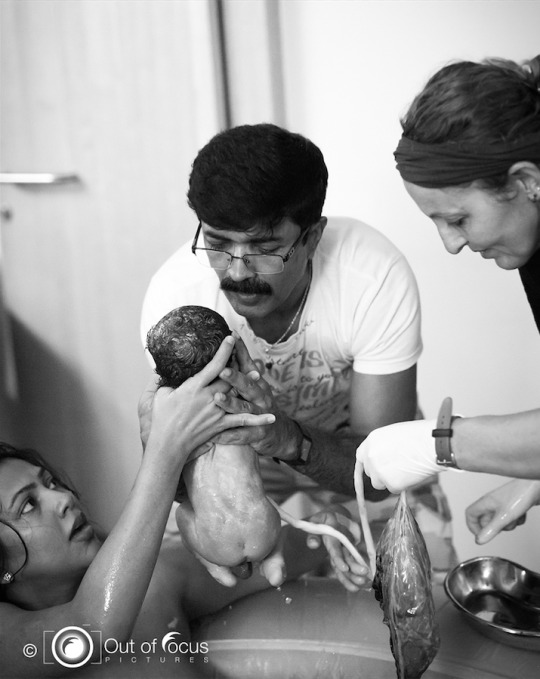
This baby is not being deprived of the transfusion of it’s own blood from the placenta. Because his cord was not cut early, he will enjoy improved health, heightened immunity, increased intelligence and potential longevity. (Photo credit: Neha Chopra, Out of Focus Photography)
At least 7,000 babies got their blood
At Bumi Sehat in Indonesia and the Philippines, we have received nearly 7,000 babies safely into the world, in high-risk, low resource settings. All of these babies enjoyed delayed umbilical cord clamping and cutting. Normally we wait 3 hours before doing anything with babies’ umbilical cords, and many parents choose keeping the cord and placenta connected to the baby until the cord naturally dries and falls away, or “Full Lotus Birth.” Both of my grandsons enjoyed this non-violent practice.
At Bumi Sehat we have experienced NO ill effects to babies through delaying umbilical cord cutting. A small study was done which compared a sample of 30 babies from Bumi Sehat (greatly delayed cord severance) and 30 babies from a local hospital with immediate cord severance. There was NO increased rate of jaundice in the Bumi Sehat babies, and they enjoyed higher hemoglobin.
Our MotherBabies enjoy a breastfeeding rate of 100% upon discharge from all three of our childbirth centers in Indonesia and the Philippines. We attribute this success of breastfeeding to the bright, enthusiastic way in which babies, born at our birth centers, bond wide-eyed and go directly to the breast to self-attach and feed. Delayed umbilical cord clamping and cutting makes it possible for babies to be bright and energetic. Babies subjected to immediate cord severance suffer from newborn anemia and all of their bonding and breastfeeding activities are impaired.
Severe anemia makes any and all newborn activities, such as gazing, crawling toward the breast, nuzzling, staying awake, latching and suckling, nearly impossible. I sing praises to the determined mothers who manage to bond and breastfeed their infants, in spite of immediate cord severance. Humans are super resilient, but that is no reason to abuse them at birth.
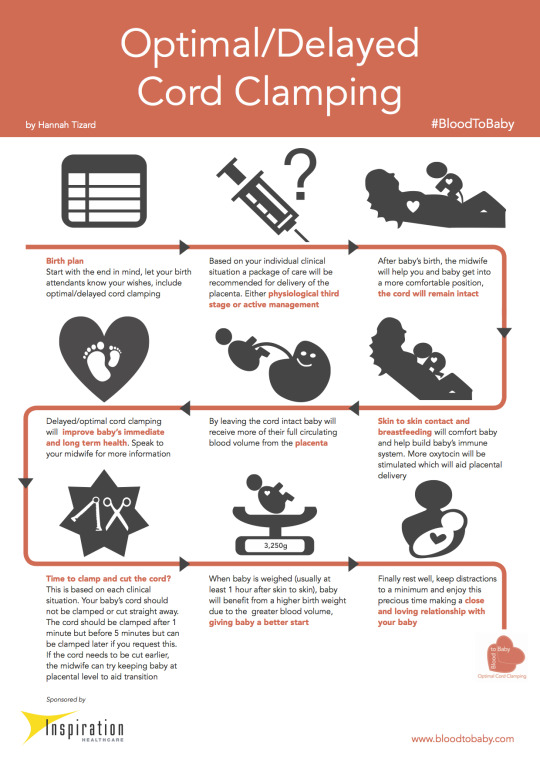
Just Say No
No other mammal, except humans, routinely interferes with bonding and breastfeeding by quickly severing the umbilical cords of their offspring.
No matter if you are rich or poor; educated or not; brown, black, white, red, yellow or of mixed race, Muslim, Christian, Buddhist, Hindu, Pagan, Catholic, Jewish or Agnostic, very young or quite mature, if you go to a medical institution for childbirth, your baby will be robbed of up to 1/3 or 33% of his or her/his natural blood supply.
Just say “NO, I will not allow anyone to abuse my newborn by immediately clamping and cutting my Baby’s umbilical cord!”
If you were born in a hospital or clinic, it happened to you. If you plan to give birth in nearly any medical institution on Earth, it will happen to your baby, unless YOU demand time for your baby to receive all of the blood he or she is meant to have. (9)
Immediate or early clamping and cutting of babies’ umbilical cords is the biggest most widespread, medically sanctioned Human Rights issue on Earth! Together, we can make this a thing of the past. May our babies all be blessed by our patience.
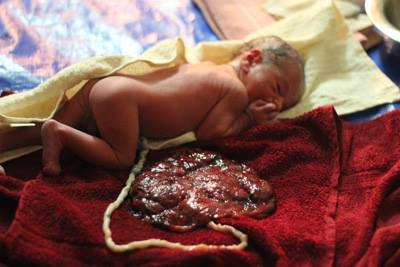
This is the non-violent practice of “Lotus Birth” in which the baby and placenta and left in-tact until the cord dries up and comes off. Obviously, this baby wasn’t shy any of his blood! (Photo credit: Lina Duncan, midwife)
REFERENCES
(1) BMJ. 2011 Nov 15;343:d7157. doi: 10.1136/bmj.d7157.
(2) Indian Pediatr. 2002 Feb;39(2):130-5.
(3) JOURNAL OF TROPICAL PEDIATRICS, VOL. 58, NO. 6, 2012
(4) Judith S. Mercer, PhD, CNM, FACNM, Debra A. Erickson-Owens, PhD, CNM J Perinat Neonat Nurs r Vo 2012Rethinking Placental Transfusion and Cord Clamping Issues
(5) http://midwifethinking.com/2011/02/10/cord-blood-collection-confessions-of-a-vampire-midwife/
(6) http://midwifethinking.com/2011/02/10/cord-blood-collection-confessions-of-a-vampire-midwife/
(7) http://www.whale.to/a/morley17.html
(8) Die Wahrscheinlichkeit, dass ein Mensch im Laufe seines Lebens überhaupt eine Stammzelltransplantation (egal ob ausNabelschnurblut oder Knochenmark) braucht, schätzt die Uniklinik in Heidelberg auf 0,06% bis 0,46% abhängig vom Lebensalter, das erreicht wird. Entsprechend gering ist die Wahrscheinlichkeit, dass bei einer Transplantion das eigene Nabelschnurblut verwendet wird: Die Schätzungen reichen von einer Wahrscheinlichkeit von 1:1400 bis 1:200.000. http://www.babycenter.de/a36661/warum-ist-nabelschnurbluteinlagerung-umstritten#ixzz3EKUNPq4X
(9) Late umbilical cord-clamping as an intervention for reducing iron deficiency anemia in term infants in developing and industrialized countries: a systematic review. http://www.epistemonikos.org/de/documents/e068abb1a37d6f4c343068377945144da56c483f?doc_lang=en

Ibu Robin Lim, CPM, is a midwife practicing in Indonesia. She, along with midwife Deborah Flowers, co-created the online resource Awakening Birth in an effort to call attention to the care of mothers, babies and their families, and the sanctity of birth as a basic human right. She is the founder of Bumi Sehat, a free clinic and birth center in Bali, Indonesia.
In 2011 she was recognized as the CNN Hero of the Year, and has received many other honors and awards.
She is the author of several books, including After the Baby’s Birth…A Woman’s Way to Wellness, and The Geometry of Splitting Souls. Her newest book, The Ecology of Gentle Birth has just been released in 2016.
See Ibu Robin's books and articles, NICE Guidelines UK, and Hannah Tizard’s www.bloodtobaby.com #WaitForWhite #WaitForWeight
Don’t miss the action at Human Rights in Childbirth Conference in Mumbai India.
Sign this petition to make it mandatory that Indian hospitals declare their c-section rates!
Check out Human Rights in Childbirth on Facebook.
Ask questions, find support and information at Birth India’s Facebook Support Group.
4 notes
·
View notes
Photo

Do you want your baby to keep 66% of or 100% of their blood at birth? 👣 That may seem like a no-brainer, but after a baby is born it's common for their umbilical cord to be immediately cut. 🚼 Did you know that 1/3 of your baby's necessary blood is still circulating through the cord to the placenta at that time? It only takes a few minutes for the blood to return into baby's body. You can tell by looking at the color of the umbilical cord: When there's blood still flowing through it, the cord is dark and plump. Once that transfer is complete, the cord becomes white and limp. Don't watch the clock, watch the cord. 👍 WAIT FOR WHITE. ⌛ • • • #optimalcordclamping #delayedcordclamping #waitforwhite #bestforbaby #birthisbeautiful #birthinginstincts #healthybaby #cutthecord #newborn #newdad #newmom #birth #pregnancy (at Doula Heidi Duncan - Expecting New Life Birth Services)
#healthybaby#cutthecord#newdad#waitforwhite#delayedcordclamping#birth#optimalcordclamping#birthisbeautiful#pregnancy#birthinginstincts#newmom#newborn#bestforbaby
0 notes
Video
✨Divine.✨ @humanbirthproject ・・・ Just the cutest thumbsucker at two hours old who has nursed and is waiting to be examined. Check us out @intactbirth - bringing awareness to waiting before clamping. #waitforwhite #bloodislife #delay @humanbirthproject
0 notes